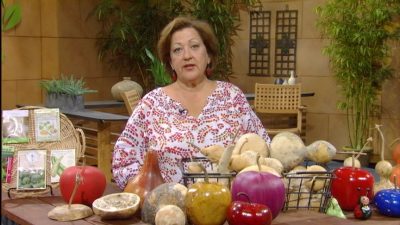Gourds

Gourds have been used for centuries for birdhouses, musical instruments, dippers, containers, bowls, and just for decorative purposes. They are many shapes and sizes from apple gourds to birdhouse gourds, bowl gourds, and the loufa sponge type gourd.
They’re very easy to grow. You can find seeds at your local nursery or garden center. After the last chance of freeze, plant four or five seeds per spot in a very well prepared soil with lots of organic matter. Most of them will have about 100 to 110 days to harvest, so plant as soon as you can.
Thin seedlings to two plants, the healthiest plants, and provide them strong support. If they’re hanging, they tend to get better shapes.
They’ll form a thick canopy of vines for shade all summer long and some can grow up to 20 feet or more. Generally, you’ll harvest between ten and twenty gourds per vine with the largest gourds coming from the very first pollinated of the flowers.
Gourds have very few insect problems. Occasional aphids, maybe cucumber beetles or stink bugs, and vine borers sometimes bother them. Loufas seldom have any bug problems at all.
Gourds do appreciate regular compost or occasional organic fertilizer for best yields and to keep the vines very healthy.
Harvest when the vines start to lose their leaves, and the stems turn brown. They should be very firm to touch. If you harvest too soon, the gourds will rot.
To dry: it may take four or five months. They can be dried outside. In fact, you don’t really want to dry them indoors because they’re quite smelly. They’re okay outside, but put them in shade and turn every few weeks to make sure that they dry evenly. You’ll hear the seeds rattle when they’re good and dry. And, they do cross pollinate freely, so the seed might not be true to type if you want to break them open and plant again.
Once dry, you may want to clean them. I like to just display baskets of gourds in their natural condition to show off have the wonderful mottling of mold on them. But, if you want to clean them off, you can spray them really well. I sometimes take them to a car wash to really blast the mold off. You can also soak them and then scrub them with a metal pot brush or you can sand the mold off. Just make sure you wear a very good mask because the membranes inside and the outside covering can be very harmful to your lungs.
You can finish them in many different ways. Use shoe polish, wood stains, latex or acrylic paint for the look you want. Note: if you’re going to use the gourds outside for birdhouses, make sure you’re using a non-toxic type wood stain and let it dry very well. You can also use pens and wood burning tools to decorate your gourds.
Cut them open to make bowls, dippers, or bird houses. You can use a band saw, pruning saw or even a hacksaw. Be sure to wear eye protection.
For more information on growing and using gourds, visit the Texas Gourd Society.
categories:
tags:
related:

 Trisha Shirey
Trisha Shirey